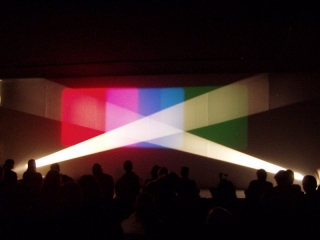Shoot Shoot Shoot: DVD Launch and Performances
Date: 24 November 2006 | Season: Shoot Shoot Shoot 2006 | Tags: Shoot Shoot Shoot
SHOOT SHOOT SHOOT: DVD LAUNCH AND PERFORMANCES
Friday 24 November 2006, at 8PM
London Candid Arts Trust
A special expanded cinema performance event to mark the release of the new LUX / Re:Voir DVD “Shoot Shoot Shoot: British Avant-Garde Film of the 1960s and 1970s”.
The evening will include two performances: Guy Sherwin’s Configuration has not been performed since 1976, and William Raban’s Wave Formations will be projected for the first time in its new arrangement.
Guy Sherwin, Configuration, 1976, for 2 x Super-8 projectors and live performer, 10 min
“In this film performance a hand-held projector and a stationary projector reproduce the movements of the two cameras used in making the film. The film was made outdoors in a clearing in a wood. The filmmaker held one camera and moved in a circle around the stationary camera while recording variations of the same view. The two cameras occasionally cross each other’s path. In time we see the gradual approach of a figure towards the two cameras and her subsequent involvement in the act of filming. During the performance, the two films are projected together onto a screen. The performer holds one projector and moves in a circle around the stationary projector, echoing the original camera movements. At times, shadows of projector and projectionist are thrown upon the screen.” —Guy Sherwin, 2006
William Raban, Wave Formations, 1977-2006, for 5 x 16mm projectors, 2 x strobe lights and live performer, 25 min
“Part one: Variation in Density: The picture on each of the five screens are identical, seven second fades from black, through clear, to black again. The same fade is printed onto the optical sound track to synchronise with the picture. Then follow fades from light to dark. And from dark to light. Part Two: Intermittency: Relative patterns of occlusion and exposure occupy two screens. Each exposure fires a stroboscopic flash of colour: yellow for one screen; blue for the other, filling the centre of both screens with colour, haloed with after-image complementaries.” —William Raban, 1978
